Male Viking Finn Costume Replicas
© Satu Hovi 2002 / 2017
This article and the replicas were created for a competition of medieval crafts during 2001-2002. This is a documentation of the process of making these replicas. Yes, I got a first price!
No part of this text is allowed to be cited or published without my permission. Please note that methods of research get better all the time, and new interpretations may appear.
It is a well known "fact" that throughout Scandinavia during our period all men wore the same clothes, although women’s dress differed. However, this "fact", like many urban legends, is not true. Men’s garment details differed according to nationality, and there were some elements that were typical to the Finnish Male costume of the Viking era.
During the Viking Age, Finns of the west coast were buried instead of cremated. They were buried with many of their goods and wearing their best clothing. Finnish women used bronze spirals to decorate their clothing, and because of that some pieces of their garments survived. Unfortunately men were less likely to use the spirals, so we have fewer extant examples to study. However, there are some pieces left. Since very little is left, we have to remember, as Professor Lehtosalo-Hilander says "It is dangerous to believe that we know everything there is to know about the Finnish male garments, luckily the situation is a lot better with the Finnish female garments" (lesson).
Parts of the garment
Tunic
In a cemetery in Eura, on the west coast of Finland, a 9th century grave of a Finnish man was found. Professor Lehtosalo-Hilander describes that grave, number 90, this way: 'The upper torso of the male was dressed in garments made from at least two different types of fabric. Although both fabrics are woolen twill, they can be distinguished, because in one the weft is spun in different directions, i.e. four adjacent yarns were alternatively Z- and S-spun. The spiral ornaments were sewed to this fabric, while in the textile found beneath a large penannular brooch, all the wefts were Z-spun. This suggests that the spiral ornamented garment was not a cloak but possibly a smock. This is also suggested by a seam discovered beneath a spiral ornament located on top of a spiral fire-steel. The fragment was upside down upon being discovered, which means that the seam was facing upwards. The same fabric was found beneath the fire-steel; it had 10-11 S-spun warps and approximately 9 wefts per centimeter.' (Luistari IV, p. 198)
Fabrics with alternately spun wefts have also been found in three other graves from the same time period in the cemetery of Luistari, and at least two of the remains are from a cloak. (Luistari IV, p.198) The woven result is interesting: one colored but still visible in the certain type of light. Picture: Male grave in Luistari cemetery in 9th-10th century (Suomen historia I, p.349)
According to professor Lehtosalo-Hilander this type of weaving does not appear in other part of Scandinavia, nor other parts in Finland (which may occur from the fact that male graves from that period have not been found elsewhere in Finland). This type of weaving has been found from Austria, Halstadt-culture period, from 7th century BC. (Valtonen, p. 5)
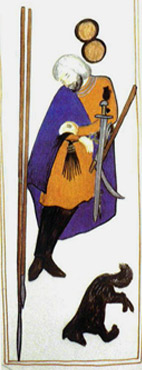
Spinning
I bought the Z-spun thread I used, and only spun the S-spun thread myself, with a drop spindle. The drop spindle was the type of spindle used in the Viking era. I did not do all the spinning myself: my husband did some of it. Sometimes the result is too tight; in the weft such tightness, which is good in warp, is not necessarily needed. In ancient Finnish dress reconstructions, in five of them, the weft is always recommended to be made of loosely spun yarn.
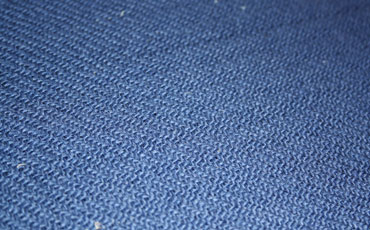
Here in my work I chose the thickness of 10 warps and approximately 9 wefts per centimeter, as it was in the most upper piece of textile in the grave 90. The warp I bought from the store, it is plied and has tex 90x2. In Viking Age Finland women were able to spin the yarn strong enough to be used in warp without being plied, but also plied yarns were used in warps. (Lehtosalo-Hilander, Euran puku ja muut muinaisvaatteet)
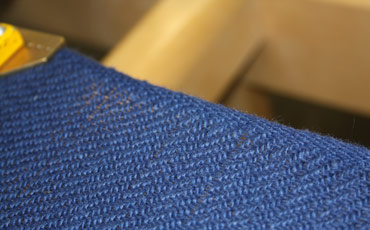
Weaving
I wove the fabric using a modern loom. It is thought that during the Viking Age Finland cloth was only woven on warp-weighted looms (for example Lehtosalo-Hilander, Riikonen). Warp-weighted looms are a simpler in construction than modern loom, but it is still possible to weave fine and complicated fabrics with it. Working with it is about five times slower than using vertical looms. With warp-weighted looms it is difficult to keep the fabric width even, because the building of the loom is simpler, also the building of the bandage wanted is made manually after building the loom, not between the building like in modern looms (Raitio). However, recently I have found information from Köyliö, which is situated also at the western coast Finland, that there has been found 3/3 woven twill, which is woven on vertical looms instead of warp weighted ones (Tomanterä). The archaeologists think it was imported, but that means vertical looms were possible. The cloth I wove is 4/4 twill, which is common in Finnish Viking Age finds. The finest twills found from Luistari graves have 20 warp yarns per centimeter. Those Carelian graves, which have 40 warp yarns per centimeter, are probably have been imported. (Lehtosalo-Hilander, Euran puku ja muut muinaisvaatteet)
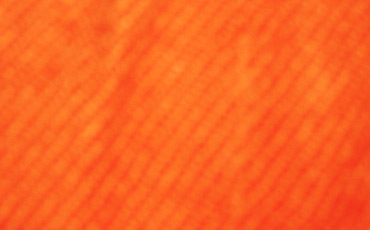
Dyeing
I decided to warp the loom using thread of a natural color, because I wanted to create a long piece of cloth, and then dye it in pieces. In color analyses from Luistari cemetery, it was noticed, that the color did not go through the yarns totally, and professor Lehtosalo-Hilander thinks that the dying was sometimes done to the finished cloth versus the thread (Euran puku ja muut muinaisvaatteet).
I bought some madder (Rubia tinctorum L.) and used it to dye the cloth. Madder is said to be the only source for red color in the Viking Age Finland (Lehtosalo-Hilander) and it was used in the wealthy Luistari graves (Lehtosalo-Hilander). My dyeing result is perhaps a bit more brown than optimal with madder. This could be because my liquid was a bit too warm. But, the latest investigations, made in a modern laboratory in York, has proved that the red in one of the graves in the cemetery in Kaarina, also in the west coast of Finland, did not come from madder, it was dyed with the grey moss which grows on the stones (Parmelia saxatilis) (Riikonen, symposium). The resulting color is a brownish red. Also, to get good red from madder a lot of roots is needed (Hassi), and I have noticed when investigating ancient dresses that in many rich graves mostly smaller pieces, like belts, were red and the bigger pieces of cloth were other colors, often blue and green. So, the end result, is that the color I wound up with is correct.
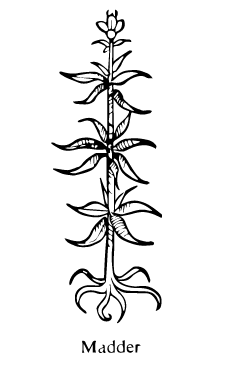
It is, in fact, surprising how little red color there was in the west coastern Viking age graves. There are a lot of blue colored fabrics in the wealthy graves, and a lot less red. Woad (Isatis tinctoria L.) and indigo (Indigofera tinctoria), which both supposed to have been the source of blue color in Viking Age (Lehtosalo-Hilander), are not easy either. Indigo is an imported good and to dye with woad, you need to collect a huge amount of leaves, and the process to dissolve the color is said to be a lot of work (Raitio, morsinkovärjäys). I think that the Finns appreciated blue color more than red.
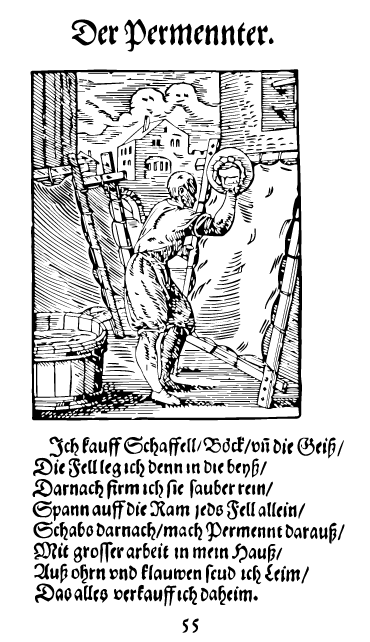
Cutting the fabric
The cut is very simple, like in most period costumes, some rounding is made under the arm to ease in movement: I do not want my husband to rip his clothes right away. There are no large tunic remains, so no patterns could be taken from Finnish graves (Lehtolsalo-Hilander) so I decided to cut a simple basic tunic.
According to professor Lehtosalo-Hilander (Euran esihistoria), the method of finishing the woven garment with table woven bands using the woven warp as the weft of the band, came to Finland from Scandinavia some time before the Viking Ages. So using a tunic pattern from earlier Denmark is a reasonable choice, since that shows that techniques traveled into Finland from Scandinavia during or before the time of my study.
Sewing and finishing
Though there are a few surviving seams from the Finnish graves (Appelgren-Kivalo, Lehtosalo-Hilander), I have used the seam structures found in the Danish Hedeby graves (Hägg). The side seams were sewn like this, which is a good choice, and it keeps its position well. The neck hole finishing method is interesting: the end of the fabric, which is hidden with a finger looped braid and the turn is finished with double rows of simple stitches, has also found from Hedeby. The finger looped band I have made after the Finnish Viking Age finds (for example. Tomanterä).
The hem and sleeve of the tunic are finished with a tablet woven band. This was a common method of finishing women's clothes in the Viking Ages (Lehtosalo-Hilander). Lehtosalo-Hilander also finds it possible that this kind of finishing might have also been used in male clothing (Euran puku ja muut muinaisvaatteet). My husband wanted more red in the garment, so I made table woven braids from the madder-red colored wool. The yarn is a bit thicker than what is found in the grave finds from the rich Luistari graves (from the info from the instructions of making reconstructions of the female ancient dresses), but the color effect pleases my husband, who in the end is the one who is going to wear the outfit.
There is also one grave in the Luistari cemetery, in which woven bands were found which were of a different color than the fabric (Lehtosalo-Hilander, Euran puku ja muut muinaisvaatteet). The madder red yarn was sold to me by Mrs Erja Kaarina Helkiö, who sells the material for ancient female costume from Eura. Just red like this is called an 'Eura red' because so many bands with exactly same red have been found from all around the west coast. That is why many archaeologist's assume that there likely was a person or an entire village, who sold tablet woven bands to a bigger area (Sarkki, Lehtosalo-Hilander).
Seam constructions from Hedeby finds (Hägg, p.150)
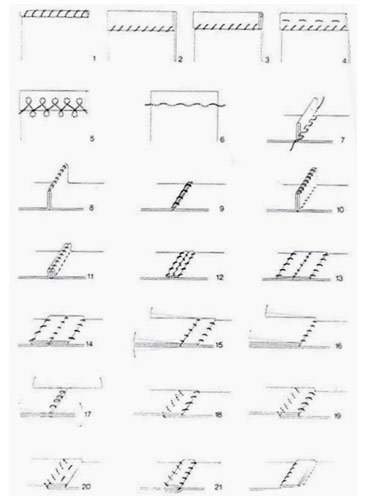
Lehtosalo-Hilander finds this red to be very typical of the area of Eura (Ancient Finnish costumes) The model of the tablet woven band is taken from the Luistari woman's grave upper garment from around 1050, which is my favorite model among the fabric end finished bands. This kind of finishing is very common in Finland (Sarkki, Lehtosalo-Hilander) and the structure of the band, called brick model weave, is said to be very typical especially for Finland, though not uncommon in the rest of Scandinavia. (Sarkki).
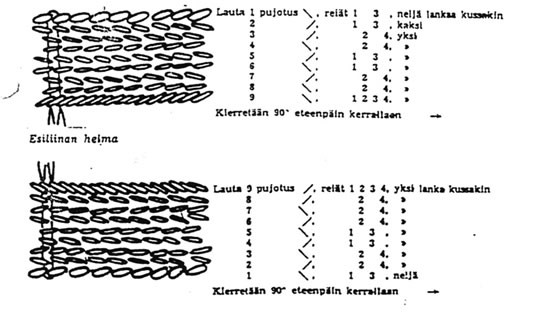
In the fabric end tablet woven bands the yarns are not put in each four holes of the tablet, the opposite twos by pairs, then chancing the corners. Often the woven bands are finished with bronze spiral decorations, typically sewn to women's apron corners (Lehtosalo-Hilander), but not always, as in the women's upper dresses (Lehtosalo-Hilander) where those spirals would be under the arms and in the hem, which is not practical and also hidden, so other people won't see it. So here the spirals are left out, because they would be in very unpractical (sleeve) or hidden (sides) places.
A corner of the tunic I made. Notice the red tablet woven band as the hem finishing. Leftovers from the loom ends can be seen here in the wrong side between the band and the fabric. Picture © Satu Hovi 2005.
The finishing the woven garment with table woven bands using the woven warp as the weft of the band. First, I took a group of warps (3-6 in tunics) which I used as a weft and placed them to the left through the open warp. Then I turn the tablets and placed the group of warps back to the right through the open warp.
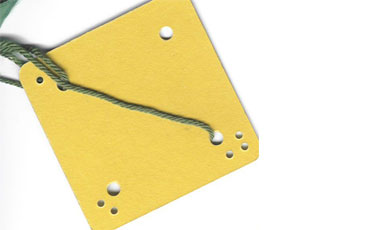
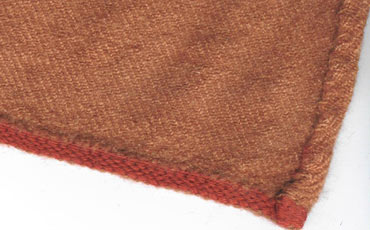
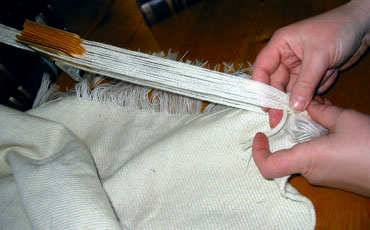
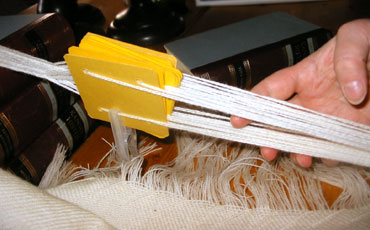
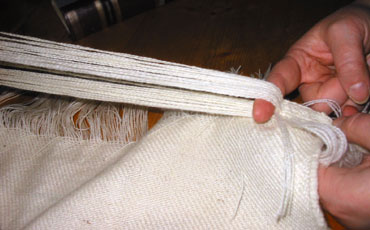
Decoration
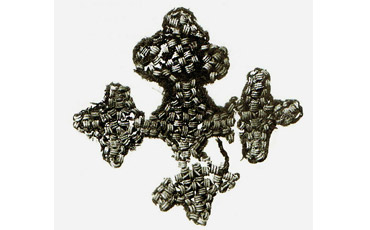
In the grave 90 in the Luistari cemetery bronze spiral ornaments were attached (sewed) to the tunic. I have made four red finger looped bands which are decorated with spiral pieces. Finger looped bands with bronze spirals are typical to the west coast Finland (Vahter), and in the grave 56, where a highly decorated women's apron was found, the spirals were put into red yarn finger loops while the apron itself is green (Luistari I). The biggest spiral ornament is in the grave 90 was found where the middle of the stomach would be, but it is assumed that it moved from where it originally was. There is only one of them, which either has been in the middle of the breast or there has been other(s), which are now lost or broken.
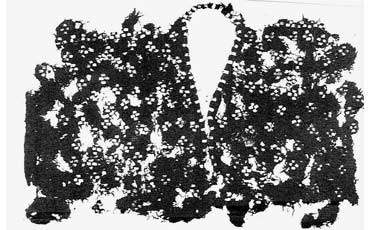
This bronze spiral ornament decoration was not used in the rest of Scandinavia (Lehtosalo-Hilander, Geijer etc.), but there is a tunic from Viking era Estonia which has sewed spiral decoration around the neck (Tallgren). Also there is a find from Lithuania, a man's tunic with plenty of spirals attached to the fabric (Zarina). So, this tunic represents features that are more common to the Baltic area during the Viking Age than Scandinavia.
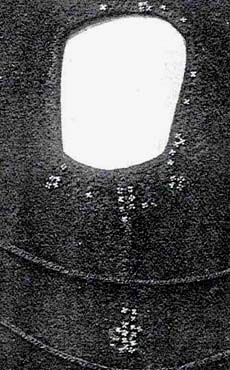
Detail of an Estonian Viking Age tunic (Tallgren).
The belt
Round tablet-woven bands used as belts, worn doubled around the waist, were found in seven graves from Luistari cemetery (Lehtosalo-Hilander). In grave 90 a couple of centimeters of the band has survived under the fire steel (Luistari I), and professor Lehtosalo-Hilander has concluded that the band was made with ten square tablets, each using a thread in every table corner, making a total of 40 threads. Grave 90 is the only grave in the cemetery where a piece of an actual belt fabric has survived, in the other graves only the spiral lines are left (Lehtosalo-Hilander). In some graves, some pieces of the finger looped bands between the spirals crossing each other are left (Luistari I), but it is not clear that these pieces are from belts. In many of those graves leftovers of finger looped bands have survived inside the spiral pieces.
I made a round tablet woven band. A band becomes round, if the weft is always put inside the warp from the same side.
The warp of the band in grave 90 is woven into finger looped bands and spiral pieces are put on those (Lehtosalo-Hilander). Only some of the finger looped bands have survived inside the spirals (Lehtosalo-Hilander). Professor has drawn a picture, where she plans the order of the loops, which I disagree with. On my opinion the spirals have moved from their original place during the centuries.
Here begins my investigations: when finishing the warp with finger loops, some extra thread has to be added, or ignored, to match. But, also in the finishing of female 12-13th century cloak ends, a bunch of extra threads are added to match the amount of finger loops with spiral decoration (the making instructions of the reconstructions of the ancient Perniö dress). Large pieces of the cloaks in many graves from around the year 1200 in Perniö area have survived because of the spiral decoration (Appelgren-Kivalo).
Spirals in grave number 100 in Luistari cemetery (Luistari I, p.407).
The idea to the pattern to this belt end is taken from the grave number 100 in Luistari cemetery. It is damaged, but the idea can be seen clearly. My reconstruction is made from a bit thicker yarn than the original, but this is again the so called 'Eura red' which is close to the idea of west coast Finnish dress and feels good in use (my husband has used earlier reconstructions already).
The spirals are made from bronze wire that is a bit thinner than was used in the period of the outfit, because that was the only size I could get. The spiral wire should be about 2 millimeters thick. Thinner wire, like the one I am using here, seems to appear in younger grave finds. Those are found from 13th century Karelia, where they were much smaller in diameter and decorated women's apron hems in large surface (Lehtosalo-Hilander, Ancient Finnish Costumes).
Again, no belts exactly like this are found in Sweden or Denmark (Lehtosalo-Hilander), but there is a leather belt from Gotland with spirals (Geijer & Arbman, Thunmark-Nylén) as well as some remaining belts from Lithuania (Zarina). Neither of those are totally similar, though.
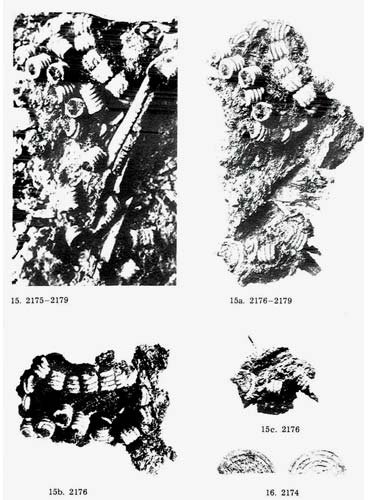
(The picture from a belt from Luistari cemetery, grave 100. (from Lehtosalo-Hilander: Luistari 1.)
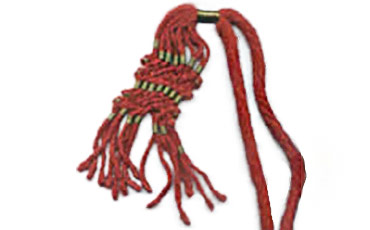
Picture: The belt I made. © Satu Hovi 2005.
The cloak
According to professor Lehtosalo-Hilander in many graves of wealthy men, traces of a blue (dark blue) cloak were found. There are several, and she thinks that in the west coast Finnish society of the Viking Age, a blue cloak was a sign of wealth or appreciation. (Euran puku ja muut muinaisvaatteet).
The blue color of the cloak was dyed either with indigo (Indigofera tinctoria ) or woad (Isatis tinctoria L.) (Valtonen), which is a common archaeophyte in Finland. Indigo was imported. Both of these plants include the same type of color pigment. In grave 348, from 10th century in the Luistari cemetery, traces of cloak were found woven with wefts using both Z- and S- spun thread, 4 of each in a turn (Lehtosalo-Hilander). It makes an interesting light effect. The size of the cloak can be estimated from the position of little spiral corners in the grave. It was about 110 cm wide and surprisingly short, only about 160 cm (a consultation of Erja Valtonen, now Erja Kaarina Helkiö).
I did the weaving myself using a modern loom. I bought the yarn for both the warp and weft, colored and spun from Erja Kaarina Helkiö, a lady who helped with the investigation of the first reconstruction of this cloak and made it. The reconstruction is visible in the National Museum of Finland. Nowadays she sells both material and ready made Viking male cloaks.
The cloth is again 4/4 twill, as the surviving pieces in grave 348 in Luistari cemetery. The thickness of the warp and weft is about 9. The warp thread is Tex. 90x2 and the weft thread tex 165, which is as close to the thread thickness in the grave as possible. (After the consultation of professor Lehtosalo-Hilander to Erja Kaarina Helkiö).
The selvage construction is something that does not appear in Scandinavia anymore during the Viking Age. From a small piece of fabric in grave 348 that could be investigated, the selvages of the cloak were woven into a hollow tube selvage, in the final weaving instructions Erja Kaarina Helkiö recommends the one of 16 yarns in both selvages. These hollow tube selvages are common in Viking Age Finnish women's graves; they appear commonly in the apron and upper dress selvages (in fact finds of those garment without these selvages are rare). Those hollow tube selvages were used in all of Scandinavia during the migration period, but were still in fashion only in Finland during the Viking Age (Lehtosalo-Hilander, Euran esihistoria). I think that it is an approach typical to the warp weighted looms, and while those were in common use in Finland in the Viking Age and not anymore in the other Scandinavia, Finns were the only one's that continued that form of weaving.
I found the weaving of hollow tube selvages to be difficult. The warp yarns have to be very tight; a lot tighter than the rest of the warp. The mundane working instructions made by Erja Kaarina Helkiö ( the same method appears also in all the other working instructions of ancient Finnish dresses, made by others), are difficult to a non-professional weaver. After weaving this cloak I have read the graduate work of Elisa Torvinen, from the University of Helsinki, where she wove a Viking age woman's cloak using tablet weaving band tablets, the selvage warp yarns in table holes, when weaving her work in the modern looms, instead of complicated, modern method of weaving. Miss Torvinen did not have much trouble with weaving the cloak, according to her text. That sounds simpler, and I am sure the Vikings used tablets when making hollow tube selvages, too. Together with the hollow selvages seems to travel the method of weaving a tablet woven band both to the start and the end to the fabric. Those methods of finishing seems to travel together in the fabric pieces found from Finnish women's graves from the Viking age. The tablet woven bands are woven using fabric warp yarns as a weft of the band. Typical to Finland is, as I have written earlier, that there is a yarn only in two corners instead of four in the middle of the band. This band was made from 24 yarns, 4 yarns in the side tablets and two in the middle ones (Valtonen, Viikinkimiehen viitta, p. 8). My husband has built me a wooden rack, which helps weaving fabric end tablet woven bands.
Again a typical sign for Finnish grave finds together with fabric end tablet woven bands is that the tablet warp is formed into finger looped bands, into which some spirals are attached. From grave 348 those are formed into a beautiful detail (Luistari I and Valtonen, working instructions) where the finger looped bands twist between each other and the spirals.
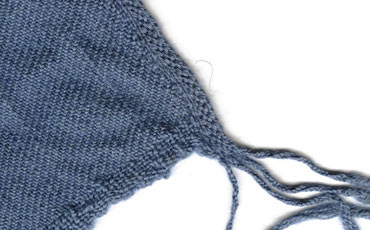
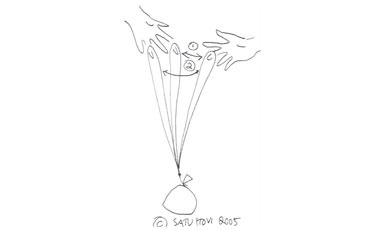
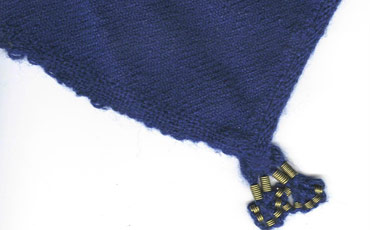
Picture: A corner of my cloak.
© Satu Hovi 2005.
Other parts of the dress
No traces of pants have been found from the Finnish graves, or traces of any headdress and only an idea of any shoes (Lehtosalo-Hilander, Euran esihistoria). Many graves have marks of mittens made with nålebinding.
Bibliography
Published sources
Appelgren-Kivalo, Hjalmar: Suomalaisia pukuja myöhemmältä rautakaudelta. Helsinki, 1907 (1908).
Geijer & Arbman: En detalj i den Gotländska mansdräkten under vikingatiden. Fornvännen 1940.
Hannusas, Susan & raitio, Sari: Morsinkovärjäys - historiaa ja kokeiluja. Turun maakuntamuseon monisteita 12. 1997
Hassi, Terttu: Kasvivärjärin ohjekirja.
Hägg, Inga: Berichte ûber die ausgrabungen in Haithabu. Bericht 20. Die textilfunden aus dem Hafen von Haithabu. 1984.
Ken kantaa kalevalaa. Kalevala Koru 100-year celebration exhibition booklet. 1985.
Lehtosalo-Hilander, Pirkko-Liisa: Ancient Finnish Costumes. Helsinki, 1982
Luistari 1-II. SMYA 89. Helsinki, 1989.
Luistari IV. SMYA 107. Helsinki, 2000.
Euran esihistoria. Vammala 2000
Euran puku ja muut muinaisvaatteet. Vammala 2001.
Raitio, Sari: Kankaiden aloituksia ja lopetuksia sekä putkihulpion kutominen loimipainoisissa pystykangaspuissa. Turun maakuntamuseon monisteita 2. Turku 1991.
Sarkki, Seija: Suomen ristiretkiaikaiset nauhat. HYAL moniste no 18.
Suomen historia I. Weilin & Göös, 1982.
Tallgren, A. M.: Esihistoriallinen puku Viron Pärnumaalta. Suomen Museo 1923.
Thunmark-Nylén, Lena: Dräkt och dräktsmycken på Gotland under vikingatiden. Gutar och Vikingar.
Tomanterä, Leena: Kaksi Köyliön miekkahautaa. HYAL moniste no 16. Helsinki, 1978.
Vahter, Tyyni: Pronssikierukkakoristelun teknillisistä menetelmistä. Suomen Museo 1949.
Working instructions for the ancient dresses from Perniö and Mikkeli.
Zarina, Anna: Neue Funde der Lettgallischen Männertract aus dem 11. Jahrhundert. Textilsymposium Neumünster (NESAT V), Neumünster, 1994
Unpublished sources
Helkiö, Erja Kaarina before called Valtonen), a written consultation and weaving instructions of a men's cloak, February 2001.
Torvinen, Elisa: Vilusenharjun vaippa. Rekonstruktio Tampereen Vilusenharjun kalmiston haudan numero 2 myöhäisrautakautisesta naisten vaipasta. Syventävien opintojen tutkielma, Helsingin Yliopisto, kasvatustieteellinen tiedekunta, 1997.
Valtonen, Erja (now called Helkiö): The weaving instructions for the ancient dress from Eura.
Valtonen, Erja (now called Helkiö): Viikinkimiehen viitta. Artesaanityö. A graduation work from the Satakunta School of Handcrafts.
Working instructions for an ancient dress from Carelia
Non-written sources
Lehtosalo-Hilander, Pirkko-Liisa: a lesson held in the National Museum of Finland in March 12th, 2002.
Riikonen, Jaana: a lesson held in the symposium of ancient Finnish dresses held in Helsinki on February 2nd, 2002.